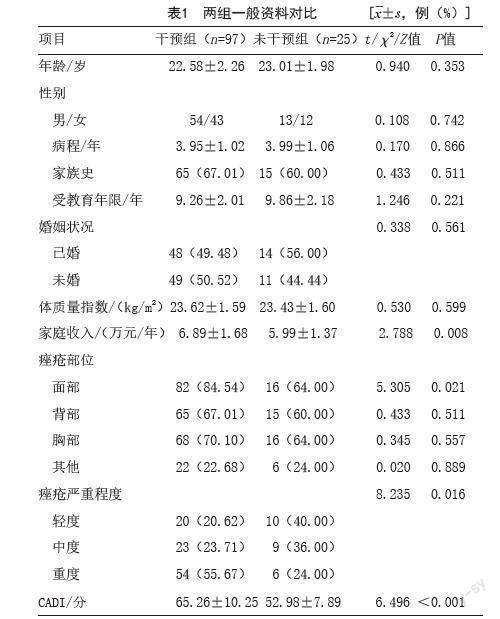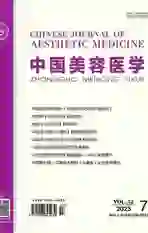寻常痤疮患者美学干预情况及其影响因素分析
2023-08-09彭诗韵央金徐冰
彭诗韵 央金 徐冰


[摘要]目的:探討寻常痤疮患者美学干预情况及其相关因素。方法:选取2021年1月-2021年12月笔者医院门诊就诊的寻常痤疮患者122例,记录所有患者美学干预情况(使用护肤品、美容介入手术等手段辅助治疗寻常痤疮),同时根据是否进行美学干预分为干预组和未干预组,比较两组人口社会学特征、疾病情况、生活质量等资料。采用多因素二元Logistic回归分析寻常痤疮患者采取美学干预的相关因素。结果:122例患者中,97例采取美学干预者分为干预组[干预组中53例(54.64%)使用护肤品,29例(29.90%)接受过美容介入手术治疗,15例(15.46%)接受过护肤品+美容介入手术治疗],25例未采取美学干预者分为未干预组;两组痤疮位于面部、痤疮严重程度、Cardiff痤疮伤残指数(The cardiff acne disability index,CADI)、家庭收入对比差异有统计学意义(P<0.05);多因素二元Logistic回归分析显示,痤疮位于面部(OR=12.567,95%CI=1.189~132.817)、痤疮程度重(OR=4.195,95%CI=1.174~14.984)、CADI高(OR=1.209,95%CI=1.053~1.388)、家庭收入高(OR=7.042,95%CI=2.004~24.751)为寻常痤疮患者采取美学干预的影响因素(P<0.05)。结论:寻常痤疮患者采取美学干预现象较为常见,痤疮位于面部、重度痤疮、CADI高、家庭收入高者更倾向性于选择美学干预。
[关键词]寻常痤疮;美学干预;严重程度;生活质量
[中图分类号]R785.733 [文献标志码]A [文章编号]1008-6455(2023)07-0102-04
Analysis of Cosmetic Intervention and Influencing Factors in Patients with Acne Vulgaris
PENG Shiyun1,YANG Jin2,XU Bing1
(1.Department of Dermatology,Chongqing Fuling Central Hospital,Chongqing 411102,China; 2.Department of Cosmetic Dermatology,Chongqing Zheng Quan Lige Medical Beauty Outpatient Clinic ,Chongqing 400014,China)
Abstract: Objective To investigate cosmetic intervention and related factors in patients with acne vulgaris. Methods A total of 122 patients with acne vulgaris who visited the outpatient department of the author's hospital from January 2021 to December 2021 were selected, and the cosmetic interventions of all patients (use of skin care products, cosmetic interventional surgery and other means to assist in the treatment of acne vulgaris) were observed. At the same time, the patients were divided into an intervention group and a non-intervention group according to whether or not the cosmetic intervention was performed. Multivariate binary Logistic regression was used to analyze the related factors of cosmetic intervention in acne vulgaris patients. Results Among the 122 patients, 97 patients who took aesthetic intervention were classified as the intervention group [53 patients (54.64%) in the intervention group used skin care products, 29 patients (29.90%) received cosmetic interventional surgery, 15 patients (15.46%) received skin care products + cosmetic interventional surgery], 25 patients who did not take aesthetic intervention were classified as the non-intervention group.There were statistically significant differences in acne location, acne severity, Cardiff Acne Disability Index (CADI), and family income between the two groups (P<0.05). Multivariate binary Logistic regression analysis showed that acne was located on the face (OR=12.567,95%CI=1.189-132.817),severe acne (OR=4.195,95%CI=1.174-14.984), and high CADI (OR=1.209,95%CI=1.053-1.388) and high family income (OR=7.042,95%CI=2.004-24.751) were the influencing factors of cosmetic intervention in acne vulgaris patients (P<0.05). Conclusion Aesthetic intervention is more common in acne vulgaris patients. Those with acne on the face, severe acne, high cardiff acne disability index and high family income are more inclined to choose aesthetic intervention.
Key words: acne vulgaris; cosmetic intervention; severity; quality of life
寻常痤疮是毛囊皮脂腺单位的一种慢性炎症性疾病,以皮脂溢出、粉刺、丘疹、脓疱为主要特征,甚至可能出现结节和假性囊肿[1]。超过85%的青少年曾患有痤疮,50%会延伸到成年期[2]。寻常痤疮治疗多予以药物治疗,部分患者认为寻常痤疮仅为青少年时期的一种常见表现并非疾病。因此,患者更倾向于使用护肤产品、介入等美学干预手段作为寻常痤疮常规药物治疗的补充[3-4]。大多数护肤产品不被视为药物,大部分患者会选择以此作为寻常痤疮治疗的替代手段,可能导致患者采取不恰当的辅助治疗手段。因此,本研究试图调查寻常痤疮患者用于治疗或补充目的的护肤产品及美容程序及患者选择这些美学干预的影响因素,为临床寻常痤疮的治疗提供理论依据。
1 资料和方法
1.1 一般资料:选取2021年1月-2021年12月于笔者医院门诊就诊的122例寻常痤疮患者为研究对象,所有患者均签署知情同意书,观察所有患者美学干预情况,同时根据是否进行美学干预分为干预组和未干预组。122例患者中,97例采取美學干预者归为干预组,25例未采取美学干预的归为未干预组。干预组中53例(54.64%)使用护肤品,29例(29.90%)接受过美容介入手术治疗,15例(15.46%)接受过医学护肤品+美容介入手术治疗,见图1。采用多因素二元Logistic回归分析寻常痤疮患者采取美学干预的相关因素。本研究经医院伦理委员会批准。
1.2 纳入和排除标准
1.2.1 纳入标准:①符合寻常痤疮诊断标准[5],面部、前胸、背部出现对称分布粉刺、丘疹及脓疱;②年龄18~25岁;③痤疮综合分级系统评分<38分。
1.2.2 排除标准:①合并湿疹、荨麻疹等过敏性皮肤病;②合并多囊卵巢综合征;③职业暴露或药物不良反应所致痤疮样皮损者。
1.3 方法
1.3.1 一般资料收集:收集患者年龄、性别、体质量指数、病程、婚姻状况、痤疮严重程度(轻度、中度、重度)、Cardiff痤疮伤残指数(CADI)、痤疮部位(面部、背部、胸部、其他)、家庭收入情况。
1.3.2 美学干预手段
1.3.2.1 医学护肤品:清洁局部皮肤后,根据皮肤类型选择具有功效性护肤品,或对痤疮部位皮肤进行清洗,采用离子喷雾机热蒸气喷雾治疗,持续3~5 min,随后使用痤疮针刺破脓疱,促使脓液排出,在患处涂抹面膜后去除并清洗局部。
1.3.2.2 美容介入手术治疗:予以强脉冲光、激光、光子嫩肤等治疗,取治疗设备,根据痤疮部位及面积调整合适的参数予以治疗,治疗后冰袋局部冰敷15 min。美容介入手术+医学护肤品为接受医学护肤品联合任一美容介入手术治疗。
1.3.3 质量控制:该研究实施阶段,严格注意病例收集过程中可能存在的误差。用Epidata软件对数据进行平行双录,保证数据准确无误。
1.4 统计学分析:采用SPSS 22.0统计学软件对数据进行分析,符合正态分布的连续变量以(x?±s)表示,采用独立样本t检验;计数资料用[例(%)]表示,采用χ2检验比较组间差异,等级资料采用秩和检验;采用Graphpad Prism绘制寻常痤疮患者美学干预情况;采用多因素二元Logistic回归分析筛选寻常痤疮患者美学干预情况的相关变量。检验水准α=0.05。以P<0.05为差异具有统计学意义。
2 结果
2.1 一般资料对比:两组患者痤疮位于脸部、痤疮严重程度、CADI评分、家庭收入对比差异具有统计学意义(P<0.05),其余因素对比差异无统计学意义(P>0.05),见表1。
2.2 美学干预的多因素二元Logistic回归分析:以寻常痤疮患者是否采取美学干预作为因变量(干预=1,未干预=0),以痤疮位于面部、痤疮严重程度、CADI和家庭收入作为自变量进行多因素二元Logistic回归分析,结果显示:痤疮位于面部、痤疮程度、家庭收入为寻常痤疮患者采取美学干预的影响因素(P<0.05),见表2~3。
3 讨论
寻常痤疮已被全球疾病负担项目列为全球第八大流行疾病,全球痤疮的患病率约9.4%,影响6.5亿青少年和成人[6]。尽管寻常痤疮有成熟的医学治疗方法,但仍有部分患者会担心治疗的副作用并寻求药物治疗的替代方法。既往研究显示[7],暴露因素会影响痤疮的严重程度和持续时间,激进的皮肤护理方案和不合适的化妆品会通过改变皮肤屏障和微生物群而导致痤疮发作,因此,应选择合适的美学干预手段。在拉丁美洲国家,非处方药清洁剂和保湿剂已被用作痤疮辅助治疗的重要手段[8];Liu J等[9]研究显示,激光治疗、光疗和化学换肤等美容介入手术治疗也逐步被部分痤疮患者作为常规药物治疗的辅助,这些研究说明寻常痤疮患者寻求美学干预手段已成为当前流行趋势,了解寻常痤疮患者美学干预情况及其相关因素有助于探究患者偏好以提供合适的美学干预建议。
护肤产品和美容介入手术被用作寻常痤疮常规治疗的辅助或补充。一项调查显示[10],保湿剂是最常用的护肤品,其次是粉剂,但未指定使用这些产品的百分比。在一项针对140名青少年患者的研究显示[11],90%参与者称至少使用过一种护肤品用于治疗寻常痤疮,但研究对象仅包括青春期女性。Salameh F等[12]发现,寻找寻常痤疮替代治疗方法即接受美容介入手术的患者比例可达26.7%。这些研究说明寻常痤疮患者美学干预情况较为普遍。本研究79.51%寻常痤疮患者接受过美学干预手段,其中85.57%使用护肤品,32.99%接受过美容介入手术治疗,22.68%接受过护肤品+美容介入手术治疗,说明了寻常痤疮患者美学干预情况的普遍性。护肤品和美容介入手术治疗为常见美学干预手段。提示临床皮肤科医生除了寻常痤疮的药物治疗外,还需要提高社会对皮肤美容产品的认识,了解患者选择美学干预的相关因素,指导患者选择合适的美学干预手段。
痤疮的发生对面部美观度影响较大,一定程度上会给患者造成心理负担。杨婷婷等[13]研究显示,面部痤疮可降低患者皮肤美观满意度。相较于胸背部的痤疮,痤疮位于面部者更注重痤疮的治疗[14]。本研究观察发现采取美学干预手段者面部受累占比较高,且进一步分析显示,痤疮位于面部是患者选择美学干预的影响因素。面部痤疮者美观度受到一定影响会降低个人自信心,因此迫切需要采取美学干预手段。本研究还发现,相较于轻中度痤疮者,重度痤疮患者采用美学干预手段比例更高。痤疮越严重,患者躯体、心理等各方面受疾病影响的程度也越严重,这种情况可能会迫使患者选择额外的美学干预手段。
既往研究显示[15],城市和农村地区的痤疮患病率存在差异,且不同经济水平的患者享受的医疗服务存在差异。根据加拿大的一项研究[16],收入低于2 000美元/年人群中仅17%会转诊皮肤科医生,而收入超过8 000美元/年的高收入人群中有24%会咨询皮肤科医生或选择护肤品等美学干预手段。另外,Giesey R L等[17]研究显示,经济收入高者选择化妆品、护肤品或激光手术、光动力疗法等辅助治疗的占比较高。本研究显示,家庭月收入高者更愿意接受美学干预,说明经济条件是决定寻常痤疮患者选择美学干预的相关因素。经济水平的提高,患者对生活品质的要求也随之提高,因此在经济条件允许下患者倾向于美学干预的情况也更为普遍。生活质量具有多维性,能从多角度评估整体健康状况情况。寻常痤疮的社会心理影响早已被确定,可严重影响患者个人生活质量。Aslan KM等[18]研究显示,采取护肤品治疗的痤疮患者生活质量评分高于未使用护肤品者。本研究中,采取美学干预措施者CADI高于未采取美学干预者,说明生活质量是影响美学干预的重要因素。当生活质量受损时,患者可能会采取干预手段予以改善。
综上,寻常痤疮患者采取美学干预现象较为常见,痤疮位于面部、重度痤疮、CADI高、家庭月收入高者更倾向性于选择美学干预。但本研究仅观察了寻常痤疮美学干预情况及影响因素,未对其他类型痤疮进行研究;因各种条件限制,未能针对不同美学干预手段分组研究,无法评估不同美学干预手段的相关因素,这可能会对本研究结果造成一定影响,后期将弥补上述不足,进一步探究。
[参考文献]
[1]罗帅寒天,毛梦平,龙海,等.2019年寻常痤疮研究的新进展[J].实用皮肤病学杂志,2021,14(1):29-31,35.
[2]Chen H,Zhang T C,Yin X L,et al.Magnitude and temporal trend of acne vulgaris burden in 204 countries and territories from 1990 to 2019: an analysis from the Global Burden of Disease Study 2019[J].Br J Dermatol,2022,186(4):673-683.
[3]Zhao J,Wang Y,Jiang L,et al.The application of skin care product in acne treatment[J].Dermatol Ther,2020,33(6):e14287.
[4]Conforti C,Chello C,Giuffrida R,et al.An overview of treatment options for mild-to-moderate acne based on american academy of dermatology, european academy of dermatology and venereology, and italian society of dermatology and venereology guidelines[J].Dermatol Ther,2020,33(4):e13548.
[5]中國痤疮治疗指南专家组.中国痤疮治疗指南(2019修订版)[J].临床皮肤科杂志,2019,48(9):583-588.
[6]?nal E,Karada? A S,?ikar Aktürk A,et al.Analysis of 3702 patients with acne vulgaris and concomitant comorbidities in Turkey: a multi-centered, prospective, controlled study[J].Int J Dermatol,2021,60(5):597-604.
[7]Dreno B,Shourick J,Kerob D,et al.The role of exposome in acne: results from an international patient survey[J].J Eur Acad Dermatol Venereol,2020,34(5):1057-1064.
[8]Andriessen A,Rodas Diaz A C,Gameros P C,et al.Over the counter products for acne treatment and maintenance in latin america: a review of current clinical practice[J].J Drugs Dermatol,2021,20(3):244-250.
[9]Liu J,Liu L,Zhou L,et al.The effect of intense pulsed light on the skin microbiota and epidermal barrier in patients with mild to moderate acne vulgaris[J].Lasers Surg Med,2021,53(10):1348-1355.
[10]Kim M R,Kerrouche N.Combination of benzoyl peroxide 5% gel with liquid cleanser and moisturizer SPF 30 in acne treatment results in high levels of subject satisfaction, good adherence and favorable tolerability[J].J Dermatolog Treat,2018,29(1):49-54.
[11]Alexis A F,Woolery-Lloyd H,Williams K,et al.Racial/ethnic variations in acne: implications for treatment and skin care recommendations for acne patients with skin of color[J].J Drugs Dermatol,2021,20(7):716-725.
[12]Salameh F,Shumaker P R,Goodman G J,et al.Energy-based devices for the treatment of Acne Scars: 2022 International consensus recommendations[J].Lasers Surg Med,2022,54(1):10-26.
[13]杨婷婷.影响面部痤疮患者治疗依从性的相关因素分析[J].中国美容医学,2021,30(2):151-154.
[14]Kaleta K P,Bogus?awska A,Stefanis A J,et al.The skin as a mirror of internal disease: comorbidities and epidemiology of acne vulgaris and adult female acne - a cross-sectional study and current state of knowledge[J].Acta Dermatovenerol Croat,2020,28(3):133-140.
[15]Heng A,Say Y H,Sio Y Y,et al.Epidemiological risk factors associated with acne vulgaris presentation, severity, and scarring in a singapore chinese population: a cross-sectional study[J].Dermatology,2022,238(2):226-235.
[16]Felmingham C,Kerr A,Veysey E.Costs incurred by patients with acne prior to dermatological consultation and their relation to patient income[J].Australas J Dermatol,2020,61(4):384-386.
[17]Giesey R L,Mehrmal S,Uppal P,et al.Dermatoses of the caribbean: burden of skin disease and associated socioeconomic status in the caribbean[J].JAAD Int,2020,1(1):3-8.
[18]Aslan K M,Karada? A S,Alyama? G,et al.Rates of skincare product and cosmetic procedure use in patients with acne vulgaris and the effective factors: A multicenter study with 1755 patients[J].J Cosmet Dermatol,2021,14(26):1-11.
[收稿日期]2022-04-19
本文引用格式:彭詩韵,央金,徐冰.寻常痤疮患者美学干预情况及其影响因素分析[J].中国美容医学,2023,32(7):102-105.
